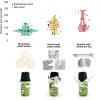3D-printed autoclavable plant holders to facilitate large-scale protein production in plants
- PMID: 36514535
- PMCID: PMC9731595
- DOI: 10.1002/elsc.202200001
3D-printed autoclavable plant holders to facilitate large-scale protein production in plants
Abstract
The Australian tobacco plant Nicotiana benthamiana is becoming increasingly popular as a platform for protein production and metabolic engineering. In this system, gene expression is achieved transiently by infiltrating N. benthamiana plants with suspensions of Agrobacterium tumefaciens carrying vectors with the target genes. To infiltrate larger numbers of plants, vacuum infiltration is the most efficient approach known, which is already used on industrial scale. Current laboratory-scale solutions for vacuum infiltration, however, either require expensive custom-tailored equipment or produce large amounts of biologically contaminated waste. To overcome these problems and lower the burden to establish vacuum infiltration in new laboratories, we present here 3D-printed plant holders for vacuum infiltration. We demonstrate that our plant holders are simple to use and enable a throughput of around 40 plants per hour. In addition, our 3D-printed plant holders are made from autoclavable material, which tolerate at least 12 autoclave cycles, helping to limit the production of contaminated waste and thus contributing to increased sustainability in research. In conclusion, our plant holders provide a simple, robust, safe and transparent platform for laboratory-scale vacuum infiltration that can be readily adopted by new laboratories interested in protein and metabolite production in Nicotiana benthamiana. Practical application Transient expression in Nicotiana benthamiana provides a popular and rapid system for producing proteins in a plant host. To infiltrate larger numbers of plants (typically >20), vacuum infiltration is the method of choice. However, no system has been described so far which is robust to use and can be used without expensive and complex equipment. Our autoclavable 3D-printed plant holders presented here will greatly reduce the efforts required to adopt the vacuum infiltration technique in new laboratories. They are easy to use and can be autoclaved at least 12 times, which contributes to waste reduction and sustainability in research laboratories. We anticipate that the 3D printing design provided here will drastically lower the bar for new groups to employ vacuum infiltration for producing proteins and metabolites in Nicotiana benthamiana.
Keywords: Nicotiana benthamiana; additive manufacturing; agroinfiltration; autoclavable 3D printing material; vacuum infiltration.
© 2022 The Authors. Engineering in Life Sciences published by Wiley‐VCH GmbH.
Conflict of interest statement
The authors have declared no conflicts of interest. The CAD templates of the plant holder (*.STL and *.SLDPRT formats) are available in the supplementary material of this article.
Figures



References
-
- Bally J, Jung H, Mortimer C, et al. The rise and rise of Nicotiana benthamiana: a plant for all reasons. Annu Rev Phytopathol. 2018;56:405‐426. - PubMed
-
- Klimyuk V, Pogue G, Herz S. Production of recombinant antigens and antibodies in Nicotiana benthamiana using ‘Magnifection’ technology: GMP‐compliant facilities for small‐ and large‐scale manufacturing. In: Palmer K, Gleba Y, eds. Plant Viral Vectors. Springer; 2014:127‐154. - PubMed
LinkOut - more resources
Full Text Sources
